Cardiopulmonary resuscitation (CPR) is a life-saving medical technique consisting of chest compressions and, at times, rescue breaths. It refers to a series of tasks meant to restore blood circulation and oxygenation during instances of cardiac arrest, such as those associated with a heart attack or near-drowning.
If you’re not trained in CPR, you might want to seek out a class. Here, we’ll describe what CPR is, provide a resource describing the steps, and explain how you can find a CPR course near you.
 “The appearance of the U.S. Department of Defense (DoD) visual information does not imply or constitute DoD endorsement.”
“The appearance of the U.S. Department of Defense (DoD) visual information does not imply or constitute DoD endorsement.”Who can perform CPR?
Anyone with sufficient physical strength can perform CPR, as it requires no tools. It does, however, require training, especially if you want to learn rescue breaths.
When cardiac arrest occurs, blood flow throughout the body stops, preventing oxygenation. Without rapid intervention, this can cause brain damage in minutes. When CPR is done successfully, it restores blood flow to the body long enough for emergency medical services to arrive and restore a normal heart rhythm.
This procedure can be performed for adults, children and infants, though it should not be done for newborns less than four weeks old.
How do you perform CPR?
The American Heart Association (AHA) provides a popular set of guidelines on how to perform CPR. The list of steps involved is likely lengthier than you realize.
After assessing the situation, you or someone nearby needs to call 911. If you’re untrained, you will be given instructions. The procedure primarily involves doing hard and fast chest compressions at 100-120 per minute. An automated external defibrillator (AED) can come in handy in these situations and requires no training as the mechanism comes with instructions.
The key words when attempting chest compressions are “hard and fast.” You might have seen CPR done on TV or in movies, where they lightly press on the chest repeatedly. They do this because using the proper amount of force required in real-life CPR could cause injury.
Persistence is often a factor, as you could be making chest compressions for a lengthy amount of time before blood flow is restored. That’s why you’ll need some physical strength and endurance.
Where can you learn CPR?
One of the top resources for finding classes that teach CPR is the AHA tool or find a class near you on the American Red Cross website. All you have to do is to enter your location. After you provide one, you’ll be presented with a list of nearby places holding official classes.
You can use the provided filters to sort results based on what type of class you’re looking for. For example, you could choose to see only Basic Life Support (BLS), Advanced Cardiovascular Life Support (ACLS), Pediatric Advanced Life Support (PALS) or other classes with specific focuses.
You can also sort by the times classes take place: morning, afternoon, evening and nighttime. Other filters include spoken languages and class format, which is either a classroom setting or a “blended learning” mix of online and in-person instruction.
Most people should start with BLS before attempting more advanced courses. Look over every option and choose a class that fits your skill level and needs.
CPR can save lives, and is worth learning
Few people know proper CPR techniques. But it’s a skill you should have for a simple reason: If there’s a medical emergency and you’re the only person capable of performing the technique correctly, it can make the difference between life and death. At such times, you might be the one person present who can save their life.

